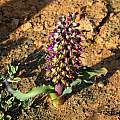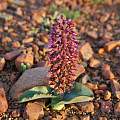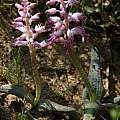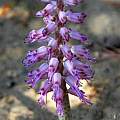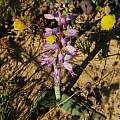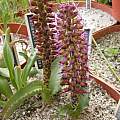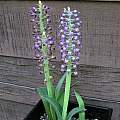Lachenalia is a genus with bulbs in the Hyacinthaceae family found in Namibia and South Africa. There are around 133 species. A complete illustrated systematic monograph of this genus by Graham Duncan, The Genus Lachenalia, was published in 2012. Lachenalia species u-z are found on this page.
Lachenalia a - Lachenalia b-c - Lachenalia Species d-i - Lachenalia j-n - Lachenalia o-p - Lachenalia q-t - Polyxena - Lachenalia index
Lachenalia undulata Masson ex Baker is found on clay flats and lower slopes in the northwest Cape and flowers in late fall-early winter (May to June). Growing from 10 to 30 cm high, it has sessile urn-shaped greenish white flowers with anthers included. Photos by Mark Mazer.
Lachenalia unicolor Jacq. is found in heavy soil in large colonies from the Bokkeveld Mountains to Somerset West, growing 8 to 30 cm tall. Graham Duncan proposed including this species in Lachenalia pallida Aiton. in his 2012 book. It has flowers on long pedicels in many different colors with green or purplish markings and blooms in the spring. Photo 1 by Mary Sue Ittner shows plants flowering in Clanwilliam September 2006. Photos 2-5 are of plants in cultivation. Photo 2 by Mary Sue Ittner. Photos 3-5 were taken by Nhu Nguyen. Photos 4-5 were taken at the UC Botanical Garden.
Lachenalia unifolia Jacq. grows on sandy granitic or sandstone soils from Namaqualand to Bredasdorp. It has a single linear leaf that is banded with green and maroon and bell-shaped blue, pink, or light yellow flowers with white tips. Flowers are variable with short or long pedicels and anthers are included. Plants grow from 10 to 35 cm high and flowering is from August to October. Photos from Cameron McMaster taken at Darling, the Biedouw Valley, the Overberg, and Namaqualand.
The first photo from Rod Saunders and the second from Mary Sue Ittner taken September 2006 in the Western Cape near Darling.
Lachenalia vanzyliae (W.F.Barker) G.D.Duncan & T.J.Edwards. was elevated to species level from Lachenalia aloides var. vanzyliae W.F.Barker by Graham Duncan in his book in 2012. It has one or two variable leaves, sometimes unmarked, but often marked purplish-brown on the upper surface. Outer flowers are pale blue to white with green or yellow-green gibbosities. The inner segments are yellow-green with white margins. Plants grow up to 25 cm. Note from Don Journet: "It certainly causes visitors to comment at the unusual colour combinations. If it is not repotted and fed every few years I find the plants become crowded and stunted and produce small flower spikes. Flowering times for me have been in the range from the fourth week in August to the first week in November (southern hemisphere)." Photos 1-2 were taken by Mary Sue Ittner. Photo 3 was taken by Colin Davis and photos 4-5 were taken by Nhu Nguyen.
Lachenalia ventricosa Schltr. ex W. F. Barker grows in moist sandy areas usually in the Northwest Cape. With a limited range, this species is found at high altitude parts of the Nardousberg and Cederberg, southeast through to the Biedouw Valley; and with another population in the Swartruggens. Plants are from 20 to 48 cm high with a single leaf with undulate margins and sessile pale yellow flowers with white tips and exserted anthers. A distinctive feature is a swollen peduncle below the inflorescence. Flowering is from August to September. The first two photos were taken by Alan Horstmann. The third photo was taken by Margaret Fox August 2020.
Lachenalia violacea Jacq. is distributed in the northwest Cape and Namaqualand where it is found in various habitats, but often in rocky places. It flowers from late winter into spring (July to September). Growing from 10 to 35 cm high, it has one or two variable leaves, broadly lanceolate and leather-like. The upper surface is plain or with dark green blotches and the leaf margins are slightly to strongly undulate and/or crisped. The bell-shaped flowers are sweetly scented, borne on suberect to spreading long pedicels, bluish green to white at the base shading to pale magenta. The stamens are exserted. The first two photos by Mary Sue Ittner were taken early morning near Middlepos in the Roggeveld in September 2006. The next two photos were taken near Middelpos and in the Komsberg by Alan Horstmann in 2023. Photos 5-6 were taken by Cameron McMaster in the Roggeveld September 2011.
The first two photos were taken by Cameron McMaster; the first was taken near Pakhuis Pass and the second in the Nieuwoudtville Reserve in the Bokkeveld Plateau. The next three photos were taken by Bob Rutemoeller and Mary Sue Ittner in the Cederberg.
The first photo was taken by Bob Rutemoeller of plants in Alan Horstmann's collection. The second photo was taken of plants in cultivation by Mary Sue Ittner.
Lachenalia violacea var. glauca W.F.Barker, see Lachenalia glauca
Lachenalia viridiflora W. F. Barker is found on granite outcrops in the Southwest Cape. This species flowers relatively early in the season (May to July). Growing from 8 to 20 cm high, it has two lanceolate leaves and turquoise shortly pedicellate urn-shaped flowers with anthers included. Compared with other species the color is remarkably uniform over the entire flower with just the tips of both inner and outer segments being markedly darker. The first photo by Digby Boswell and the second from Rod Saunders. The third and fourth were taken by Susan Hayek at Telos Rare Bulbs Nursery owned by Diana Chapman. This Lachenalia is interesting to photograph because on the camera the turquoise color virtually glows. The final photograph by Pamela Slate shows bulblet formation on a leaf cutting.
The photos below by Nhu Nguyen show two different forms from above. Photos 1-2 show a very brightly blue colored form. Photos 3-4 show a form with green petal tips.
Lachenalia whitehillensis W.F.Barker occurs along river beds in sand on adjacent rocky outcrops from the Roggeveld to the Little Karoo. Plants have narrowly lanceolate leaves (1-2) with distinctive maroon bands at the base and nodding, bell-shaped, fragrant pedicellated flowers, creamy white tinged with blue or pink flowers. Anthers and filaments are exposed. Height: 15 to 36 cm high. This uncommon species flowers from September to October. Photo from the book Plants of the Klein Karoo courtesy of Jan and Anne Lise Schutte-Vlok.
Lachenalia xerophila Schltr. ex G.D.Duncan is found in deep red gravelly sand in the Northern Cape (Richtersveld, Namaqualand and western Bushmanland). Growing from 10 to 37 cm, it has 1-2 lanceolate flat to slightly undulate and crisped leaves and oblong-campanulate faintly scented white to light mauve flowers with dark brown or mauve gibbosities and well exserted stamens. It flowers from August to September; flowers are pollinated by honey bees. Photos from Alan Horstmann.
Lachenalia youngii Baker is found in coastal areas in the southeast Cape. Growing from 7 to 30 cm high, it has two narrowly lanceolate leaves and bell-shaped flowers on long pedicels that are pale blue and pink with darker purplish pink markings. It flowers July-November. Photos from Cameron McMaster.
Lachenalia zebrina W.F.Barker is a striking species with one ovate pale arching green leaf that is banded with purple and creamy flowers fading to red on long pedicels. Anthers are well exserted. It is found on rocky clay flats in the Western Karoo. Plants grow 10 to 30 cm high and flower from August to October. Photos by Bob Rutemoeller and Mary Sue Ittner were taken of the leaves September 2006 near Middelpos in the Roggeveld. The third photo was taken by Rod Saunders. The fourth photo is of a plant growing in a disturbed area near the village of Loxton by Rogan Roth. The last photo was taken by Alan Horstmann.
Lachenalia zeyheri Baker grows in marshes and seeps in the Northwest Cape and flowers from September to October. Growing from 6 to 20 cm high, it has bell-shaped, shortly pedicellate white flowers with reddish brown or green markings. Anthers are included. The first two photos by Alan Horstmann and Mary Sue Ittner. The last two were taken in habitat near Blinkbergpas in the Western Cape by Andrew Harvie.
Lachenalia a - Lachenalia b-c - Lachenalia Species d-i - Lachenalia j-n - Lachenalia o-p - Lachenalia q-t - Polyxena - Lachenalia index























